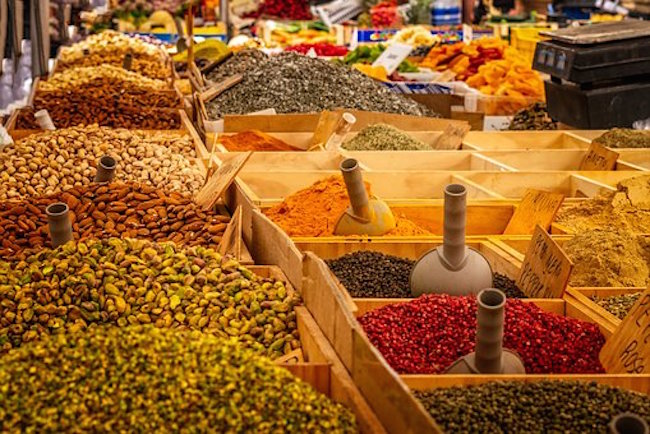How to Feed Your Family When You’re Flat Broke by Daisy Luther – The Organic Prepper
Feeding your family when you’re flat broke isn’t easy but it can be done. What would you do if you suddenly need to prepare for a lean month ahead on a tight budget? Imagine you only had $400 or so to purchase all food and essentials for your whole family for a month. How would you cover the necessities?
This is a question on a lot of people’s minds right now. Most – if not all – states are paying out February’s SNAP food benefits early to make sure that folks have something to eat during the month ahead. That means any money they get now has to be stretched to feed their families for at least 6 weeks. As well, as the government shutdown continues, 800,000 federal employees will also continue to be without a paycheck.
As usual, in an effort to deter the people who feel compelled to cheer about the misfortune of others, please remember that a lot of people receiving assistance for food are the elderly, the disabled, veterans, and children. This article explains how a lot of food stamp recipients may not be the “welfare queens” you’re envisioning.
Today’s article was written to help anyone who finds themselves in difficult circumstances. I hope it helps you make it through the rough spot.
Surviving when your budget is severely limited
Here’s an article on surviving the shutdown and here’s an article on surviving when you can’t pay your bills.
Now…about the stuff you need to buy. The lists below are specifically food, but keep in mind that there will be other needed supplies in the month too. Don’t forget about toilet paper, soap, shampoo, feminine hygiene products, toothpaste, dish soap, and any other essential that your family may require.
When choosing what to purchase (and how much) consider the appetites and preferences of your family. Yes, even when money is tight, you can purchase food your loved ones will enjoy. You aren’t being punished – it’s just a rough spot.
I just put together a PDF guide called The Flat Broke Cookbook: Thrifty Meals and Shopping Tips for Tough Times to help you through this with some tasty, inexpensive meals and shopping tips.
This cookbook is FREE to anyone who needs it and available for $5.49 to anyone who wishes to purchase it.
Here’s how to get it:
If you need a free copy, no questions asked, drop us an email at daisyluther2 at gmail.com with the subject line FREE COOKBOOK. It may take us a day or two to get this out to you but I promise every person who needs it will get it.
If you would like to purchase a copy for $5.49 go here: https://sowl.co/6AJ7P
The book has loads of thrifty recipes and leftover ideas to reduce waste, as well as some shopping tips for getting through a lean month or two.
Where to shop
Remember, all grocery stores aren’t created equally. In every area, there’s always a “cheap” store. I find that in my part of the world, Food Lion and Walmart are a fraction of the price of Kroger, even with the sales. Walmart has inexpensive groceries in most areas.
Also check out places like Aldis and Lydl. Some items that are name brand can be purchased at dollar stores and liquidation stores. Go to the least expensive place around for your shopping trip.
Some frugal food tips
Your menu this month may be a little different than what you’ve been used to before. Food may take more hands-on time to prepare.
- Cook from scratch. Remember when you’re buying food, either you’re doing the work or you are paying someone else to do the work. This month, you’re going to need to do the work. Here are some tips on cooking from scratch.
- Stretch your ingredients. Be ready to stretch your ingredients by making soups, stews, and casseroles.
- Don’t plan on eating low-carb this month. Unless, of course, you have a health condition that requires a low carb diet, plan on adding more grains and starches to your diet during a rough spot.
- Use your leftovers. Plan to use every single bite of food, including small amounts of leftovers.
- You probably won’t be able to eat organic. If you normally eat nothing but fresh, organic goodness, this month is going to have to be different. If times are really really tight, you are going to need to loosen your standards to survive.
This article talks about making healthy choices when you’re broke but if you are rock bottom broke, you may have to go even cheaper. So when I recommend canned fruits and veggies here in a minute, I don’t want to hear “But you’re supposed to be the organic prepper.” Sure. I am. I care about BPA in canned goods. But I’m also a sensible and realistic prepper and I care about people having something to eat. Just make the best choices you can while still staying fed, okay?
Protein
When you’re broke, protein is going to be the most costly part of your menu.
- Meat: When your budget is super tight, don’t expect meat to be the main dish. I’m not saying you have to go vegetarian, but calorie for calorie, meat is very expensive. Use less meat than you normally would and make it an ingredient instead of the star of the meal. Go with less expensive cuts and cook them for a long time: stew beef, ground beef, chicken quarters, etc., are much less costly.
- Eggs: Eggs are a very inexpensive and healthy source of protein. Walmart has huge flats with 30 eggs for a very reasonable price. I suggest you grab a few of those and think about breakfast for dinner.
- Beans, beans, good for your heart. I absolutely love beans and strongly recommend them. Proper soaking and rinsing can reduce the resulting flatulence. Go with dried beans instead of canned for greater savings. If your family members don’t like beans, they might prefer refried beans or bean dip. Worst case scenario, you can puree cooked beans and add them to a soup.
- Peanut butter. Peanut butter is a tasty protein source and most kids love it. (Assuming there are no allergies, of course. ) Grab a huge jar and if possible, go for one that is more natural. Skippy and Jif both have a line of natural peanut butter without a whole lot of additives.
- Canned tuna: Beware of eating this stuff non-stop because of high levels of mercury, but some canned tuna will add much-needed protein to your menu.
- Lentils and split peas: Both of these are high in protein, dirt cheap, and easy to turn into delicious soups.
Fruits and Vegetables
Produce is a very important part of a healthy diet. Without it, you’re at risk for all sorts of deficiency diseases. When shopping once a month, plan to eat your fresh stuff early in the month and then move on to your frozen or canned goods.
- Apples: If the price is reasonable, grab a large bag of apples. This will provide you with some fresh fruit.
- Applesauce: This is a great addition for later in the month when the fresh stuff is gone. To save money, look for large jars of applesauce instead of the little individual packets for lunch boxes. Go with unsweetened applesauce.
- Canned fruit: Get fruit canned in the lightest syrup possible, or fruit canned in juice. Just because you’re broke doesn’t mean you need to eat 10 pounds of sugar per day, right? Canned fruit is a nice addition to pancakes, waffles, or oatmeal. Reserve the juice for baking.
- Overripe bananas: If your store has a last-day-of-sale bin for produce, you may be able to grab some overripe bananas. Get these and take them home for banana bread.
- Carrots: I’m not talking about baby carrots here. I’m talking about those huge bags of grown-up carrots you’ll need to peel and slice yourself. Remember earlier when I told you that you’re either spending time or money? Carrots are a perfect example of that. Peel them, slice them, and keep them in a bowl of water in your fridge for yummy snacking.
- Onions: A big bag of onions will help you flavor up your home cooking this month.
- Garlic: Sometimes it’s cheaper to buy garlic already chopped up in a jar. Grab enough garlic to spice up your food over the course of the month.
- Cabbage: Depending on the time of year, a few heads of cabbage will get you far for very little money. You can use cabbage in coleslaw, salads, soup, or casseroles. You don’t need to get fancy – just go with the plain, ordinary green heads of cabbage if they’re the cheapest.
- Canned tomatoes: My favorite canned good is canned tomatoes. I like to get a variety of crushed and diced ones. These can be used for soups, chili, casseroles, and sauces. Canned tomatoes are a nutritional powerhouse.
- Frozen vegetables: At my local grocery store, I can get bags of frozen vegetables for a dollar each, and sometimes less. If you have the freezer space, this is the way to go. I suggest you grab at least 30 bags of veggies that you know your family will enjoy. Our favorites are peas and carrots, green peas, corn, cauliflower, broccoli, chopped spinach, Brussels sprouts, mixed vegetables, and green beans. With an assortment of frozen vegetables, you can make all sorts of great stuff.
- Whatever is in-season: Every season, there are fruits and veggies that are at their ripest and least expensive. What is in season depends on when your personal financial catastrophe occurs. Here’s an article on in-season winter veggies.
It’s important to get enough produce for 2-3 servings per day at the minimum. I know all the health experts tell you 5-8 servings but you may not be able to swing that. Also, potatoes would really be considered a carb but since you find them in the produce department, I added them to this list.
Dairy
If you consume dairy products on a daily basis, you’re going to still want to consume dairy products when times are tough. (Cream for your coffee, milk for cereal, a beverage for the kiddos).
Generic milk by the gallon is your least expensive way to go for this. You can make all sorts of things from your gallons of milk, like homemade yogurt and cottage cheese. (Instructions are included in the book.) I suggest you put aside enough cash to be able to pick up a gallon of milk weekly. If you don’t already have powdered milk, this isn’t the time to buy it. It tends to be a lot more expensive than fresh milk.
Milk with lower fat can be frozen. Be sure to remove at least one cup of milk from your gallon jug to allow room for expansion. This works best with skim milk. Any milk with fat will need to be shaken each time you use it.
Grab cheese by the block for the least expensive option. Because we really enjoy cheese, I pick up 2 large blocks for a month. I cut each one in half and package them up separately. I freeze 3 and keep one in the fridge. Remember, cheese is a condiment during difficult times, not the main course. You simply cannot afford cheese and crackers for dinner.
Carbs and Grains
I know this is a wildly unpopular ingredient these days, with all the low-carb and keto diets out there, but grains are the great stretchers of your pantry. You can take one serving of leftover chili and feed your entire family with it when you mix it with rice and perhaps a little bit of cheese.
Buy your grains in the biggest packages possible for the most savings. Forget about “instant” anything – these items are often totally stripped of nutrition, and again – you are spending time, or you are spending money. Here are some of the grains to look for:
- Brown rice
- Pasta
- Oats
- Quinoa
- Barley
- Flour
- Cornmeal
There are lots of other grains, but these are inexpensive, versatile, and easy to work with.
And don’t forget the humble potato. A couple of bags of potatoes can get you through a rough time. Potatoes are filling, can be cooked in a lot of different ways, and most folks love them. Leave the peel on for added fiber. Store them in a cool, dark place away from onions for the longest life. Even when they’re sprouting eyes, you can eat them though – just cut out the sprouting parts.
Basics
To turn your raw ingredients into meals, you’ll need a few basics, too.
- Baking soda
- Baking powder
- Yeast (if you are going to bake bread)
- Spices
- Sugar, Syrup, Honey
- Fats (Cooking oil, shortening, butter, lard, etc.)
- Vinegar
- Salt and pepper
How much should you buy?
This is the tricky part. How much to buy has a lot of variables and only you can identify them.
- What do you have on hand?
- How big is your family?
- How hungry is your family?
- How picky is your family?
- How long do you expect the budget to be tight?
The best option is to do some meal planning before you go shopping. This should help you identify how much you need for main meals. Don’t forget to add extra for lunches and snacks!
Getting through a rough spot
I know it’s scary to face financial problems, but you will get through this. I know it feels like the rug has been yanked out from under you. But the way you handle these difficult times is the way you will handle a disaster that is even more serious and long-term. Your determination to get through it means everything and I hope that my book can provide you with some of the tools you need to make it happen. Please don’t be shy – I really want to help. I’ve had tough times myself and I know how awful it can be. If I can make it easier for you, I’d be honored.
I know you can do this.
In the comments, does anyone have suggestions for other cheap and thrifty ingredients that folks on a limited budget should pick up?
Daisy Luther
Daisy Luther is a coffee-swigging, gun-toting blogger who writes about current events, preparedness, frugality, voluntaryism, and the pursuit of liberty on her website, The Organic Prepper. She is widely republished across alternative media and she curates all the most important news links on her aggregate site, PreppersDailyNews.com.Daisy is the best-selling author of 4 books and lives in the mountains of Virginia with her two daughters and an ever-growing menagerie. You can find her on Facebook, Pinterest, and Twitter.





